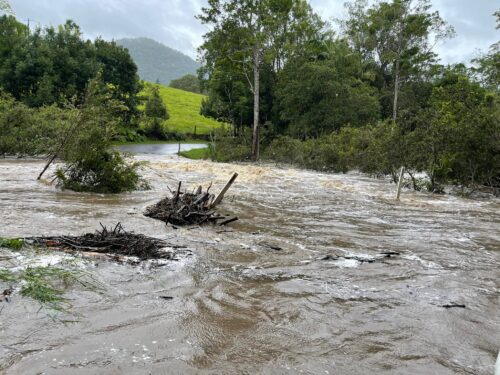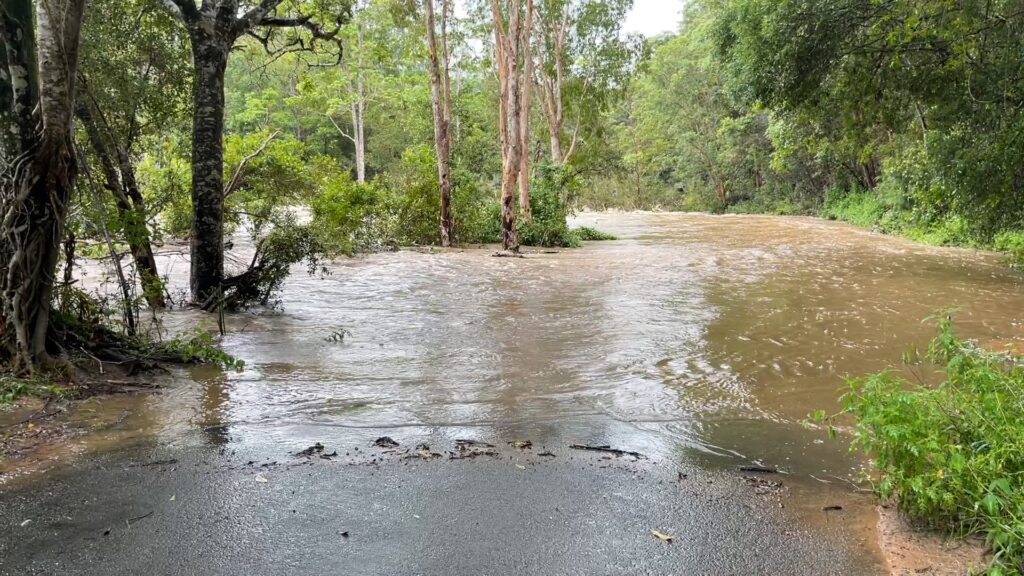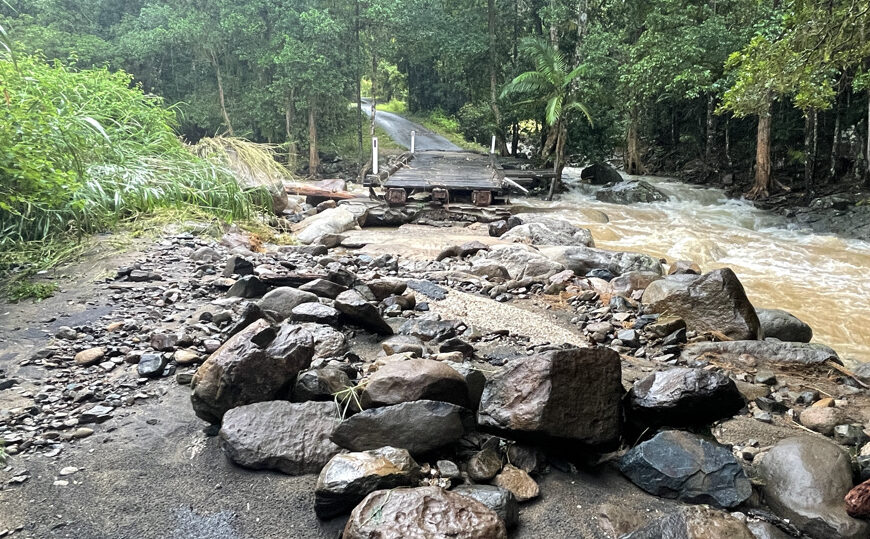Floods

The Northern Rivers has a long history of floods.
Floods are part of the natural hydro-logical cycle and play a role in sustaining certain types of ecosystems to function efficiently.
However, an exceptional flood event occurred in February 2022 due to high rainfall levels and a number of other factors.
Knowing the flood potential of where you live, work and visit in the Tweed Shire is important to keeping yourself, your family and others safe during floods.
Use the tabs below to get prepared Before, During and After an event.
Before a Flood
STEP 1: Know Your Risk
Recognise the environment that you live in.
Is your property prone to flooding?
- Find out about the local flood history (see below)
- Know the heights at which your home, business and/or property and local roads could be affected by floodwater
- Contact council if you want more information on how flooding could directly affect your property
- Talk with people who have lived in the area for a long time, to hear about their experiences of floods locally
- Be aware of the amount of rain falling in upper catchment areas that could impact your property and access to your property.
Check if you are in a flood prone area.
Check the Tweed Shire Council page to access flood information for your property and to generate a flood report
Go to the Tweed Council’s Property Flood Reports
Go to the SES’ Flood Awareness page for our LGA
Check local river heights & rainfall
Here’s a link to live River Heights and Rainfall for areas that impact Greater Uki. You can view a map of the latest river and rainfall observations at the BOM site HERE.
View River Heights for Greater Uki and Northern Rivers
View 24hr Rainfall for Greater Uki and Northern Rivers
View 1hr Rainfall for Greater Uki and Northern Rivers
Additional live rainfall data is available through private gauges in the Greater Uki area at: Mount Burrell, Byrrill Creek (Pretty Gully) and Cedar Creek, Terragon (top of Palmers Rd), Top of Smiths Creek (Ryans Rd), Bottom of Smiths Creek (Clareville Rd).
Also, you can join a community-led read-only WhatsApp thread providing updates on rainfall and river heights -(please note you should still use all available information – including warnings and forecasts from the BOM and SES – in planning your actions) Click here to request to join: https://chat.whatsapp.com/C9jBwvzSckq3g8uoRl7hrz<
See tips from the SES on getting ready for a flood
They have lots of information on their ‘things you can do before a flood’ webpage, including:
1. Know your risk
2. Know where to go
3. Know who to call
4. Know your plan
5. Get your kit together
6. Prepare now to act early
7. Check your insurance
8. Listen to local radio
Make sure you are familiar with using useful apps and links…
Make sure you are familiar with using useful apps and links during rainfall events. Often roads are affected even though it may not be flooding where you are. In particular, know your way around the Hazards Near Me App, the BOM, Tweed Shire Council (TSC) Emergency Dashboard and Live Flood Monitoring Cameras from TSC.
STEP 2: Plan
Make your Emergency Plan
To help households and businesses plan for flooding, the NSW SES has developed a Home Emergency Plan and Business FloodSafe Toolkit.
See links below to prepare your plan.
Make your plan Online
For your Home
Go to the SES’ ‘Home Emergency Plan’ page
For your Business
Go to the SES’ ‘Business Emergency Plan’ page
Check the Tweed Shire Council page to access flood information for your property and to generate a flood report
Tweed shire council flood awareness map
Go to the Tweed Council’s Property Flood Reports
Be familiar with different flood warnings
Please be aware that current Bureau of Meteorology flood warnings in our area are only issued for the Tweed River at Murwillumbah and downstream of Murwillumbah, so no flood warnings are issued for the Greater Uki area. Therefore, as mentioned above, it is very important for us to rely on local information to understand local flood conditions.
- Know the official Bureau of Meteorology flood warning products – Flood watch and flood warnings are issued by the Bureau of Meteorology
- Know the official NSW SES flood warning products – The NSW SES issues community-specific warnings once a Flood Watch or Flood Warning product is published by the Australian Bureau of Meteorology.
- View all current NSW SES WARNINGS – www.ses.nsw.gov.au
- Monitor your Flood Situation and monitor the likelihood of flash floodings and landslips.
- Learn to interpret Flood Levels issued by the Bureau of Meteorology
- Understand Dam Failure Alerts – In New South Wales dam safety is monitored in most circumstances by the owner of the dam. During heavy rainfall or a flooding upstream, high volumes of water can create additional pressure on the dam wall and may affect its structural integrity. In some instances water can be released to relieve this pressure. Prescribed dams often have early warning systems for communities that lie downstream of the dam and close to the dam.
STEP 3: Prepare
Prepare your Property
If your property is prone to flooding:
- Store all chemicals and poisons above ground level in case of flash flooding.
- Identify which indoor items you will need to raise if flooding threatens your home (e.g. freezers, fridges, washing machines).
- Identify the most important farm equipment to move to higher ground. Have a plan.
- Get out with a mattock and make sure your drains are clear – to save your road or driveway
- By taking simple actions to improve your home’s flood resilience of your home, you can avoid some heartache when the next big flood comes.
View ‘How to Improve Flood Resilience for Homeowners’ videos from Sustainable Brisbane for more information.
- Renovating a room? Now’s your chance to do it with the new flood resilient materials and design. This means it’s a simple wash-down after flooding.
Make an emergency plan for your animals/livestock
You are responsible for your animals.
Consider making an animal Evacuation Kit, tag your animals for identification and identify family or friends who can help care for your animals in the event of flooding.
If you have livestock and large animals on your property, it is important to take steps to plan for their welfare in the event of a flood.
Download the fact-sheet below to help you.
Download and print your plan below if you have animals or livestock.
Download the SES’ ‘Get Animals Ready’ fact-sheet
Get your emergency kit together
Prepare an emergency survival kit before the wet season starts.
Having a prepared kit means having easy access to things that can help you survive a flood or other natural disaster.
It will be in one handy location.
Here are some tips from the SES on how to put together an emergency kit. Keep your emergency kit in a waterproof storage container.
Your Emergency Kit contents:
- Portable radio with spare batteries
- Torch with spare batteries
- First aid kit (with supplies necessary for your household)
- Candles and waterproof matches
- Important papers including emergency contact numbers
- Copy of any Home Emergency Plans
- Waterproof bag for valuables
When leaving or evacuating your property, place in your emergency kit:
- A good supply of required medications
- Any special requirements and supplies for babies, the disabled, infirm and/or elderly
- Appropriate clothing and footwear
- Non-perishable food and drinking water
See the Emergency Kit Poster from the SES to help you with your emergency kit.
Download the SES’ ‘Emergency Kit Poster’ as PDF
Prepare to be without power and/or water for extended periods of time.
In an emergency situation, electricity connections may be down. As may the mobile phone services. If you are likely to be cut off for extended periods consider:
- having alternatives for lighting, and boiling water and cooking. This may include battery/solar powered lanterns, gas cookers, power banks and generators
- If you have a generator, please make sure you check it regularly and get extra fuel to store safely ahead of possible weather events.
- If you have a power bank be sure to keep it sufficiently charged ahead of an event.
- do you or a neighbour have satellite internet? With an alternative power source you can still make WiFi calls and get online even when power/mobile phones are down.
- Think about your water source if your water tank pump fails or if the town water supply is compromised and you are unable to leave your home to get supplies. Be prepared by filling up your bathtub and containers so you have ample water for a few days.
To stay informed, go to the useful apps & links page to download relevant apps and links.
The Tweed Shire Council Emergency Dashboard also has links to apps.
Go to the Tweed Shire Emergency Dashboard
Check out the SES resources below on flood preparation.
Go to the SES’ ‘Prepare your Home’ page
Go to the SES’ ‘During a Flood’ page
Join your neighbourhood hub & get to know your neighbours.
Go to RUKI’s ‘Neighbourhood Groups’ page
During a Flood
Check useful apps and links page. Be mindful that often roads are affected even though it may not be flooding where you are. In particular, know your way around the Hazards Near Me App, the BOM, Tweed Shire Council (TSC) Emergency Dashboard and Live Flood Monitoring Cameras from TSC.
See advice below from the SES:
In order to protect your family and property in potential flooding situations (or if a Flood Warning is issued):
- Never drive, ride or walk through floodwater.
- Stack possessions, records, stock or equipment on benches and tables, placing electrical items on top.
- Secure objects that are likely to float and cause damage.
- Relocate waste containers, chemicals and poisons well above floor level.
- Keep listening to your local radio station for information, updates and advice.
- Keep in contact with your neighbours.
- Be prepared to evacuate if advised by emergency services. (You should receive advice of where to evacuation. Also listen to ABC local radio and check Council, Red Cross and SES pages to see where evacuation centres are)
- Act early as roads may become congested or closed.
Download the fact-sheet below from the SES on what to do during a flood
Download the SES’ ‘During Flood’ fact-sheet

Know the new SES Warning System
The new SES warning system is based on the Australian Warning System and has 3 levels. Check it out here:
Go to the SES’ ‘Warning System’ page
Advice (yellow) – an incident has started. Stay up to date in case the situation changes.
Watch and Act (orange) – you need to start taking action now to prepare.
Emergency Warning (red) – you may be in danger and need to take action immediately.
![]()
Follow your Emergency Plan
The way to stay safe is to stay out of floodwater.
People get into trouble at causeways because they assume the road surface is intact underneath the water – but it could be eroded.
Once water hits the body of the car, it will start to drift – this is how people lose control.
Tune in to Alerts and Updates
- Listen live to ABC North Coast or tune in at 702AM / 94.5FM
Listen live to ABC North Coast
- BOM River Levels
Go to BOM’s ‘River Levels Northern Rivers’
- BOM Rainfall and River Conditions
Go to BOM’s ‘Rainfall & River Conditions Map North Coast’
Additional live rainfall data is available through private gauges in the Greater Uki area at: Mount Burrell, Byrrill Creek (Pretty Gully) and Cedar Creek, Terragon (top of Palmers Rd), Top of Smiths Creek (Ryans Rd), Bottom of Smiths Creek (Clareville Rd).<<
- Current SES warnings
- Hazards Near Me app
- Tweed Shire Council Facebook Page
www.facebook.com/tweedshirecouncil
- SES Northern Rivers Facebook Page
www.facebook.com/NSWSESRichmondTweed
- SES Murwillumbah Unit Facebook Page
- SES Emergency Help during floods and storms – call 132 500
Other community pages that may be useful:
- The Caldera Community Emergency Support FB Page
Go to the Caldera Community Emergency facebook page
- Murwillumbah Matters
www.facebook.com/groups/1235985433095427
- You can also check out local groups on Facebook such as: ‘Uki Community News & Social Group‘, ‘UK1 The Real Uki Community‘, ‘Mount Burrell and Kunghur Community‘, ‘Friends of Byrrill Creek‘ and there are many more depending on where you live.
Upper Tweed Flood Information Whats App Thread
There is a volunteer, citizen-led read-only WhatsApp thread with localised weather, rainfall and river height information. This information is not professional advice, but rather a compilation of data upstream of Uki as neither the BOM’s flood warning service nor the Council flood monitoring cameras provide information that is useful to local rivers and streams upstream around Uki and surrounds. People should still use all available advice, including official warnings and forecasts from the SES and BOM to take appropriate action. Here’s the link to request to join in WhatsApp: https://chat.whatsapp.com/C9jBwvzSckq3g8uoRl7hrz
Stay connected to your Neighbourhood
If you are not already part of your neighbourhood hub, find and connect with your Neighbourhood Leader if you live in the Greater Uki area.
Get to know your neighbours.
You don’t have to best friends, it’s just good to know who your neighbours are so you can check in with your neighbours and let each other know if you need help.
After a Flood
It is important to ensure that your property is safe for you and your family after a flood.
Check the SES poster below for tips on what to do post-flood.
Download the SES’ ‘After a Flood’ fact-sheet
- Tweed Shire Council’s Flood Recovery Update from the 2022 floods is regularly updated and has useful links to recovery support resources, from mental health support to infrastructure issues.
- Check our health and mental health page for more support
- Connect with community. In the event of a flood, check in with your neighbours on foot, via phone/internet or UHF radio.
- Past events indicate that either formal evacuation centres or spontaneous community-run emergency ‘hubs’ are generally formed within a couple of days of the events. If you can safely access your nearest community ‘hub’, help will likely be available there. The Uki School of the Arts Hall, Kunghur Hall, Doon Doon Hall are all spaces where community members may gather. Check ABC loca radio and local social media pages or with your Neighbourhood Leader if you’re not sure where to go.
The Australian Red Cross have put together the following advice on cleaning up after water damage.
Download the Red Cross’ ‘Cleanup’ fact-sheet
More Detailed Resources
Characterisation of the 2022 Floods in the Northern Rivers region
Download the CSIRO Floods Report 2022
See link below for the Tweed Shire Local Flood Plan
Download the Tweed Shire’s Flood Plan

Stay informed and go to the useful Apps, Numbers & Links page to download relevant apps and bookmark links.
For urgent Emergency help
phone Triple Zero 000
For Flood or Storm help
phone SES on 132 500
For fallen Powerlines, Loss of Power or other Electricity supply problems contact essential energy on 132 080